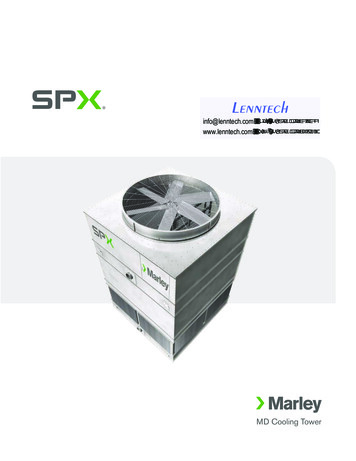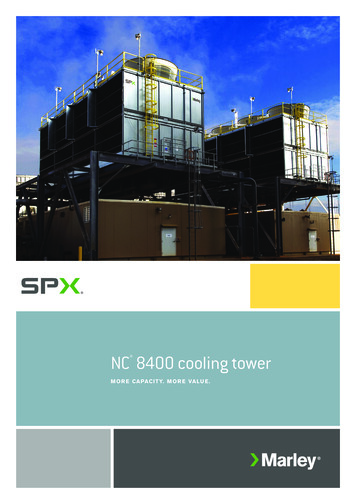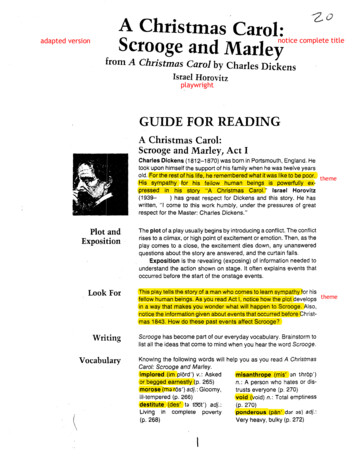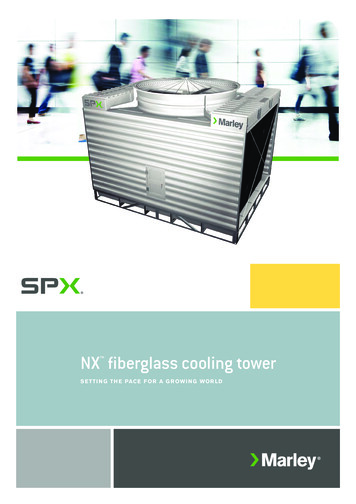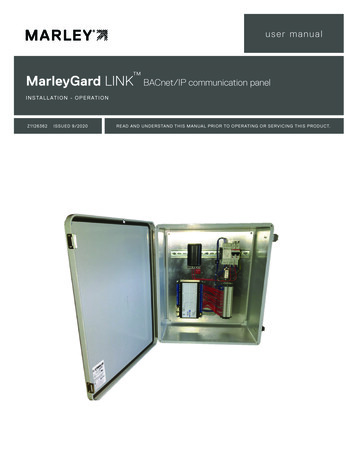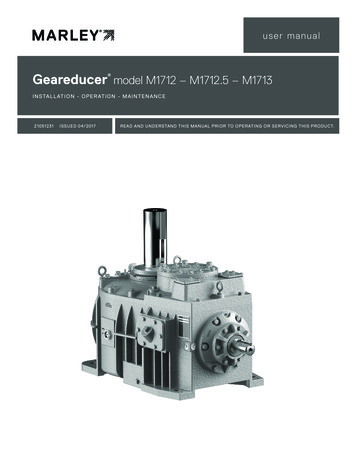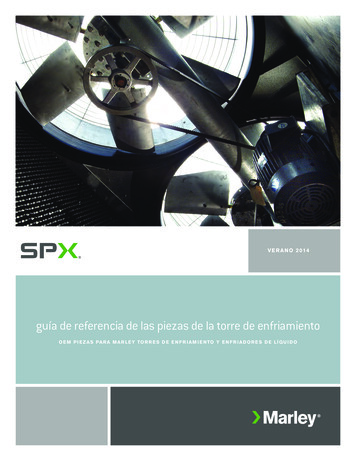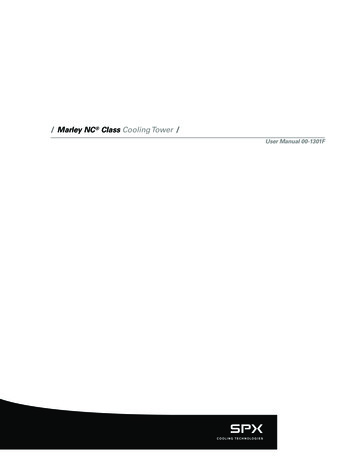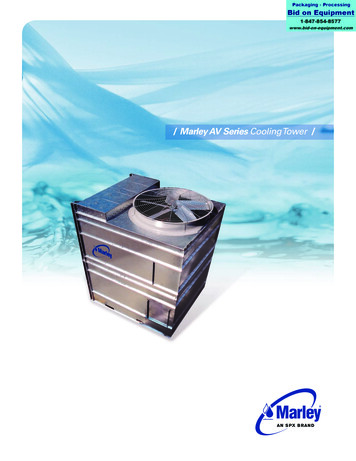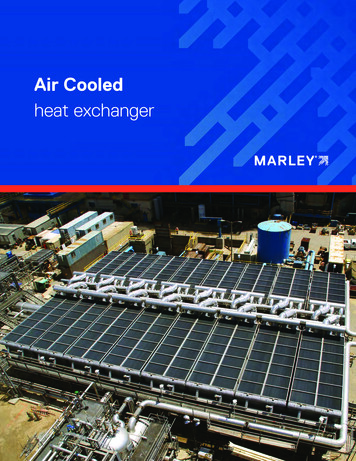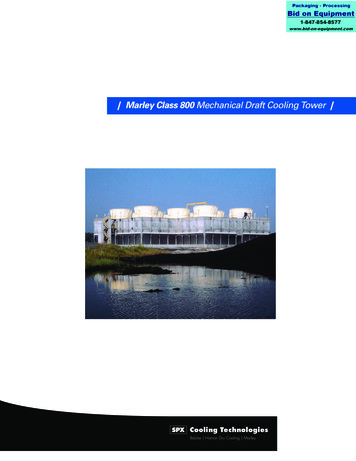
Transcription
/ Marley Class 800 Mechanical Draft Cooling Tower / }Ê/iV } ià V iÊNÊ Ê ÀÞÊ }ÊNÊ À iÞ
/ Design Integrity – Design Flexibility /8 Cell Medical Center HVAC systemThe Marley Class 800 counterflow concrete coolingMaking good on our commitments for overtower has proven itself as one of the most efficient75 yearsand reliable cast-in-place designs in the world. Theintroduction of the Precast 800 version is a logicaldesign evolution taking advantage of increasinglyavailable quality precast production facilities.Each Marley concrete cooling tower is analyzedand designed by our engineers who collectivelyhave over 200 years of product history.When Marley cooling towers require periodicLocally-produced concrete components keep workinspection, they can be serviced by the samein the country of origin, provide better dimensionalengineers who originally designed them—control, and greatly enhance scheduling by virtue ofprofessional engineers who are dedicated to theconcurrent construction capability.special requirements of concrete tower design.The environmental choiceClass 800 towers are hurricane and typhoonresistant by virtue of mass, and concrete defiesthe detrimental effects of heat and ultraviolet light.Concrete is a natural material which is ideallysuited for long service life in the harshestcooling tower environment. And concrete willnever degrade the quality of cooling watercirculating through the tower.Unobstructed Marley counterflow fill installation
/ Proven design, exceptional structural materials /8 Cell Power Station in AlabamaDesign FlexibilityClass 800 towers are available in a wide range ofoptimum cell sizes—“preferred” configurationsthat fully utilize Marley fill and nozzle geometry.However, since our primary goal is customersatisfaction, we can solve your particularrequirements with special cell sizes.Within each cell size, our design engineers canchoose from numerous possible componentcombinations. Several options may result ineconomical selections capable of the thermalperformance requirements, but only one will optimallysatisfy the fan horsepower, pump head, plan areaand other evaluation parameters contained in yourspecifications. Our engineers review each coolingtower application to assure that the componentsselected will work together as an integrated systemfor efficient performance and long life.And finally, we offer precast concrete forjobs where schedule and economics favor an“assembled” product, or cast-in-place when in situforming and casting are favored.Concrete stress test at the SPX Cooling TechnologiesResearch & Development Center
Peak fan performanceTest provenMarley FRP fan cylinders featureMarley-manufactured fans areventuri-shaped eased inlets andselected using test data fromclose blade tip clearances.wind tunnel modeling at theSPX Research and DevelopmentCenter, and performance is verifiedat actively operating installations.Non-clogging, large-diameter NS nozzlesThe spray system consists of large-diameter Marley NS spray nozzlesand additional components. These assure a uniform flow and lowoperating pump head.Plus, they free you from the expense and nuisance of cleaningclogged nozzles. The Marley NS low-pressure, non-clogging nozzlehas a consistent “solid cone” downspray pattern to assure uniformwater distribution for proper thermal performance.
Durable Marley Geareducer Simple maintenanceEffective wind controlMarley Geareducers have become theEach Geareducer is equippedLongitudinal “wind walls” extendindustry standard. They are designedwith an industrial grade lubricationdownward from the bottom ofto meet or exceed the requirements ofline, terminating outside the fanthe fill to normal operating waterCTI STD-111 and AGMA standards, andcylinder near the motor, at an oillevel to keep high winds fromare tested under load prior to shipment.level sight glass and drain.blowing through the tower. TheyNumerous reduction ratios are available soalso assure proper air supply tothat power is applied at optimum fan speed.the fill.Marley XCEL plus Drift Eliminator. Very low drift ratesThe first cellular drift eliminator wasdeveloped by Marley over twenty fiveyears ago when eliminator designs wereprimarily blade-type configurations andnot very effective. Marley patented theXCEL generation of eliminators in the early1980s. No other eliminator could comeclose to XCEL’s low drift rate and lowpressure drop.XCELplus—a more advanced design—meets or exceeds today’s demandingspecifications for drift emissions, without sacrificing fan horsepower, at halfthe original XCEL drift rate with equivalent pressure drop.Low drift rate is the primary goal of eliminator design. XCELplus boasts typicaldrift rates of .001% of the total GPM. Drift rates of .0005% and lower areavailable, depending upon the tower duty.Ask your Marley sales representative for more information.Tough MC high-performance film fillMarley MC high-performance film fill removes process heat efficiently andpredictably. The polyvinyl chloride (PVC) fill sheets are formed at the Marleyfactory to exacting quality and strength standards. Maximum performance orclog-resistant designs are available for a wide range of thermal and water qualityrequirements. And, our engineers evaluate each cooling tower application,using computer optimization analysis to select the best fill system to maximizethermal performance—thus keeping power consumption low.
/ Combining over 80 years of cooling tower experience withover 45 years of concrete experience /The first concrete natural drafttowers in North America werebuilt by Marley more than 45years ago. Since then, we havebuilt more than 30 others. In 1971,we designed and built the firstclustered-plume round concrete mechanical drafttower and have since followed with more than 40others. And, in 1986 we introduced the Marleyrectangular concrete cooling tower in both linearand back-to-back configurations—each with itsown unique advantages. The rectangular towersuccess is evidenced by the many customers nowspecifying these towers for combined cycle, steam,power plants, and petrochemical applications.8 Cell Power Station inThailand10 Cell Refinery in Indonesia
/ Concrete fits the Marley “Total Systems” approach /Class 800 technology produces a product withdefinite, predictable and measurable performance.Extensive laboratory, university and field testing forlong-term service in various climates and circulatingwater conditions has enabled us to simulate andevaluate tower longevity and performance.Here are a few of the advantages of this structure: Durability Impervious to a broad range of corrosivesubstances—immune to rot and decay. Fire resistant Marley concrete counterflow cooling towerswith our standard hanging fill are Factory Mutualapproved. Sprinkler systems are not required,saving on first cost and maintenance expense. Ease of construction Local trades have many craftspeople withbridge and building experience, and most citiesin the world have concrete mix and precastplants. Concrete alone keeps the majorityof your cooling tower costs within the localeconomy. Very stable Coefficient of thermal expansion is less thansteel. Intermittent operation Concrete is perfect for “cycled” cooling towersas it naturally maintains its structural integrity,whether wet or dry. Non-conductive Reduces the hazard of electrical shock. Environmentally friendly
/ The other side of the world is just around the corner for SPX /SPX Cooling Technologies can coordinate design andconstruction between owners, engineers, contractors andplant sites throughout the world. We operate through acomprehensive global network of offices,representatives, subsidiaries, licensees andjoint venture partners.Working in the global arena meanswe design to and keep current with allinternational codes and conventions. Weunderstand the labor, financial and otherpertinent factors involved in your project.Our global experience gives us moreinsight into the particular concerns in yourregion of the world. We want to put thisspecial blend of expertise to work for you.You simply cannot work with a more experienced team inthe world of cooling towers. Let us show you how SPX canmake a world of difference for you.Cooling TechnologiesBalcke Hamon Dry Cooling Marley/7401 W 129 Street // Overland Park, KS USA 66213 // 1 913 664 7400 // spxcooling@ct.spx.com // www.spxcooling.com/In the interest of technological progress, all products are subject to design and/or material change without notice. 2006 SPX Cooling Technologies, Inc. Printed in USACL 800MD-06
/ Marley Class 800 Cooling Tower /Product Specifications
Marley / Class 800 Cooling Tower / Table of ContentsSpecifications / BaseBaseThermal PerformanceDesign LoadingCirculating Water QualityStructureMechanical EquipmentFill and Drift EliminatorsFan CylinderWater Distribution SystemCell PartitionsAccess and SafetyScope of Work455678101111121213Specifications / OptionsOptions to Maximize Local Scope of SupplyConcrete Mechanical SupportsBottom-Supported FillConcrete Parapets and Stairways141414Premium Hardware OptionsLevel 1 – Epoxy-Coated Galzanized SteelLevel 2 – Type 316 Stainless SteelLevel 3 – Silicon Bronze151516Driveshaft Materials OptionsAll Stainless Steel DriveshaftCarbon Fiber Driveshaft / Stainless Steel Couplings1818Access and Maintenance OptionsVertical Ladder at End of TowerSecond Stairway at End of TowerCased StairwayMechanical Equipment Portable Access CatwalkMechanical Equipment Permantent Access CatwalkEndwall Derrick191919192020Control OptionsControl SystemLow Oil SwitchVibration Limit SwitchVariable Speed Drive20212122Miscellaneous OptionsClog-Resistant FillWindwallsFan Cylinder View Port232323
Marley / Class 800 Cooling Tower /3Depiction is Predominantly PrecastClass 800 cooling towers are film-fill, concretecounterflow cooling towers designed to serve allcooling water systems. They utilize both precast andformed-in-place construction techniques to meet thefast track schedules and competitive pricing requiredin today's market. The new Class 800 cooling towerincorporates the latest cooling tower technology—both in structure and components—developed byMarley in over 80 years of cooling tower experience.This publication not only relates the language to use indescribing an appropriate Class 800 cooling tower—butalso defines why certain items and features are important enough to specify with the intention of insistingupon compliance by all bidders. The left hand columnof all pages provides appropriate text for the variousspecification paragraphs, whereas the right hand columncomments on the meaning of the subject matter andexplains its value.Pages 4 through 13 indicate those paragraphs thatare descriptive of a cooling tower which will not onlyaccomplish the specified thermal performance, butwhich will include all normal operation and maintenance-enhancing accessories and features. It will alsoincorporate those standard materials which testingand experience have proven to provide best results innormal operating conditions.Pages 14 through 23 provide some paragraphs intendedto add those features, components, and materials thatwill customize the tower to meet the user's requirements.Space does not permit definition and explanation ofall of the possible options that can be applied to theClass 800 tower. SPX Cooling Technologies realizesthat you, the purchaser, must be satisfied with thetower's characteristics, and we are prepared to provide any enhancement that you are willing to defineand purchase.
Marley / Class 800 Cooling Tower / Specifications: BaseSpecifications1.0Base:1.1Furnish and install an induced draft,counterflow-type, field erected, filmfill, industrial duty, concrete coolingtower of cell(s), situated asshown on the site plan. The limitingoverall dimensions of the tower shallbe wide x long x highto the top of the fan cylinders. Totaloperating horsepower of the fans shallnot exceed hp. Tower designshall be approved by Factory Mutualwithout the need for a fire-protectionsprinkler system.1.2It is the intent of these specificationsthat the bidder shall have the optionto utilize either precast techniques,formed-in-place techniques, or areasonable combination of both inthe construction of the tower. Thechoice of construction technique shallbe based upon the bidder's ability tomeet the required construction timeframe outlined in the Owner's inquirydocuments, and shall be subject tofinal agreement between the Ownerand bidder. In all cases, appropriate guidelines promulgated by theAmerican Concrete Institute (ACI) shallbe strictly adhered to.Specification Value Your specification base establishes the type, configuration, material, and physical limitations of the cooling tower to be quoted.During the planning and layout stages of your project, you mayhave focused your attention on a cooling tower selection that fitsyour space allotment, and whose power usage was acceptable.Limitations on physical size and total operating horsepower avoidthe introduction of disruptive influences. Even further control ofthis problem will result if you specify the number of cells, and themaximum fan hp/cell.You are specifying a counterflow tower, which is a type noted—and usually specified—for its economical use of ground space onprojects where the required thermal performance is very difficult.The one you have chosen to specify is film-fill, which normallyprovides maximum cooling effect in significantly less area thanwould be required by a splash-fill crossflow tower.You are also specifying materials of construction which, althoughpremium in their costs, are impervious to many of the ills thatbeset towers constructed of more traditional materials. Long lifeexpectancy and excellent fire resistance are typical characteristicsof this tower.Note: If it is your intention to evaluate offerings on the basis offirst cost, plus the cost of ownership and operation, please beclear in your inquiry documents regarding the parameters underconsideration, as well as the value that you intend to place uponeach of them. (i.e. Dollars per hp; dollars per ft. of pump head;dollars per sq. ft. of basin area; etc.) They WILL influence the sizing of the tower.4
Marley / Class 800 Cooling Tower / Specifications: BaseSpecifications2.0Thermal Performance:2.1The tower shall be capable of coolingGPM (L/s) of water from F ( C) to F ( C) at a designentering air wet-bulb temperature of F ( C). The cooling tower manufacturer shall guarantee that the towersupplied will meet the specified performance conditions when the tower isinstalled according to plans.2.2The purchaser will arrange for an onsite thermal performance test, to beconducted in the presence of the manufacturer and owner, and under thesupervision of a qualified, disinterestedthird party in accordance with CTI(Cooling Technology Institute) StandardATC-105. The test shall be performedduring the first full year of operation.If the tower fails to perform withinthe limits of test tolerance, then thecooling tower manufacturer will installadditional cells and/or make such corrections as are agreeable to the ownerand shall pay for the cost of a retest. Ifthe tower still fails to perform as specified, then the manufacturer shall makesuch reimbursements as are appropriate and agreeable to the owner tocompensate for the performance deficiency.3.0Design Loading:3.1The tower and all its components shallbe designed to withstand a wind loadbased on ASCE-7 and a seismic loadbased on UBC. As a minimum, a stability load of 2 1 2% shall be applied tothe structure. For non-domestic jobs,a minimum design wind load of 30 psf(1.44kPa) shall be used. Fan decks andother work levels shall be designedfor a uniform load of 60 psf (2.9kPa),or a concentrated live load of 600 lbs(272kg). Allowable deflection at 60 psf(2.9kPa) uniform load shall be 1/180of span. Fill and fill supports shallbe capable of withstanding a 60 psf(2.9kPa) live load. Guardrails shall becapable of withstanding a concentratedlive load in any direction.Specification Value Your reason for purchasing a cooling tower is to obtain a continuing flow of cooled water as defined in the paragraph at left. Ifthe tower that you purchase is incapable of performing as specified, then you will not have received full value for your investment.Bear in mind that the size—and cost—of a cooling tower varies directly with its true thermal capability. This paragraph isintended to protect you against either intentional or inadvertentundersizing of the tower by the manufacturer. Judging the levelof performance of a cooling tower on critical processes is nevereasy, and the potential risk of a non-performing cooling towerusually causes the requirement for a mandatory acceptance testto be very desirable.Your contract with the successful bidder should establish theacceptable remedies for missed performance, which mightinclude: he addition of one or more cells of tower, as necessary, to Tbring the cooling tower to the specified level of performance.This is usually limited to the scope of work as defined in thespecifications, which means that you (the owner) will have topay for the additional basin, wiring, starters, piping, etc. T he reimbursement of a portion of the total contract priceequal to the percentage deficiency in performance.Under no circumstances should you allow the manufacturer torepitch the fans to increase motor brake horsepower above thatshown in the proposal. That creates additional operating coststhat will continue for the life of the tower—and imposes no penalty on the manufacturer. T he design values indicated in paragraph 3.1 are the minimumallowables under normal design standards. If your geographiclocation dictates higher wind load, earthquake load, or deck loading values, please make the appropriate changes.5
Marley / Class 800 Cooling Tower / Specifications: BaseSpecification ValueSpecifications4.0Circulating Water Quality:4.1It is anticipated that the circulating waterwill have the following characteristics:pH rangeChlorides (NaCl)Sulfate (SO4)Calcium (CaCO3)Silica (SiO2)Max. water temperatureBacteria Std Pl countTotal suspended solidsSaturation Index4.2toppmppmppmppm Fcfu/mlppm0.0 to 1.0The specifications, as written, areintended to indicate those materialsthat will be capable of withstandingthe above water quality in continuingservice. They are to be regarded asminimum requirements. Where components peculiar to individual towerdesigns are not specified, the manufacturer shall take the above waterquality into account in the selection oftheir materials of manufacture. For purposes of this specification, "normal" circulating water conditions are defined as follows: A pH level between 6.5 and 9.0. A chloride content below 1500 ppm (NaCl) — or below 910ppm (Cl -). Some material upgrades may be recommended withNaCl above 750 ppm. A sulfate content (SO4) below 1200 ppm. (Sulfates can attackconcrete, and contribute to scale.) Calcium (CaCO3) below 800 ppm. No oil, grease, fatty acid or free fiber content. Silica (SiO2) below 150 ppm. A maximum hot water temperature of 125 F. A bacteria count 10,000 cfu/ml. Total suspended solids (TSS) below 50 ppm. N o significant contamination with unusual chemicals or foreignsubstances. F or towers of concrete construction, it is imperative that aslightly positive saturation (Langelier) index be maintained.If your circulating water quality falls outside any of the parameters listed, some changes in the materials specifications may berequired, most of which are mentioned on pages 15 through 19.Where there is any question in your mind, please provide Marleywith an analysis of your makeup water, along with the numberof concentrations you intend to permit in your circulating water.Better still, since the quality of the water in a cooling tower soonreflects the quality of the surrounding air, an analysis of thecirculating water from another cooling tower on site, if one exists,might be very informative.Where the tower's incoming hot water temperature exceeds 125 F(51.7 C), details of thermal expansion provisions become increasingly important. Depending upon the size of the tower, and theresultant safety margins, some changes in tower assembly maybe required.Except for those unusual operating situations where the circulating water may be so laden with suspended solids, algae, fattyacids, product fibers, active organisms reflected in BOD, and thelike, that plugging of the fill is a probability, reasonable attention to the hardware materials and/or their coatings is all that isnormally required. Please work with your Marley sales representative.6
Marley / Class 800 Cooling Tower / Specifications: BaseSpecifications5.0Structure:5.1All concrete shall provide nominal 2"(51 mm) cover over reinforcing steelper ACI 318, and shall be designedfor 5000 psi (35 MPa) compressivestrength at 28 days. Reinforcing barsshall be deformed and shall comply with ASTM A615 Grade 60. Allconcrete shall use Type II PortlandCement and shall be air entrained.Cement mix density shall be 658 lb/yd3(390 kg/m3) of concrete. The use offly ash or curing agents shall be asapproved by the owner.5.2Structural framing connections shallbe bolted as required. No field welding will be allowed. Structural framinghardware shall be Series 300 stainlesssteel. Bidders shall include with theirquotation complete column base loadtables for all specified loading conditions. Transverse and longitudinalcolumn spacing shall not exceed 40'-0"(12.192m) on centers.5.3If precast, the concrete casing shall bebolted to the columns. The casing shallprovide support for internal structureand components, and shall stiffen thestructure for wind and seismic loads.Structural casing hardware shall beSeries 300 stainless steel.5.4Structural support beams may be castin-place or precast. Precast, if used,shall rest on neoprene bearing pads toavoid abrasion and localized stresses.Prestressed members shall not beused in the wetted area of the tower.Where prestressed members are used,tendon anchorage protection shall beprovided. Torch-cutting of prestressedtendons at the concrete face will notbe allowed.5.5Whether prestressed or cast-in-place,the fan deck shall act as a workingplatform for operation and maintenance personnel. It shall have a broomfinish for skid resistance.Specification Value SPX Cooling Technologies designs to ACI guidelines becausethey are considered to be both definitive and suitably conservative. If other authorities are to govern the design, please definethem clearly in your specification and/or inquiry documents. T ype II cement is our recommendation for the waterquality limitations indicated above. Higher sulfate levels maydictate Type IV, and brackish water may require condensedsilica fume. T he indicated mix density represents 7 bags of cement (USA)per cubic yard of concrete.To have structurally designed their offerings, bidders will havehad to develop the loading diagrams specified. Please ask forthem.Series 300 stainless hardware is appropriate for the "normal"water conditions defined on page 6. If your air or water qualitydictates hardware of higher premium (i.e. type 316 stainless steel,silicon bronze, epoxy coating, etc.), please see pages 15 through19, and discuss your requirements with your Marley sales representative.7
Marley / Class 800 Cooling Tower / Specifications: BaseSpecification ValueSpecifications6.0Mechanical Equipment:6.1The primary air delivery system foreach cell shall consist of an electricmotor, an extended drive shaft, ageared speed-reduction unit, a multibladed propeller-type fan, and a rigidunitized support.6.26.36.4Motors shall be -speed, singlewinding, variable torque, hp maximum, TEFC, and specially insulated forcooling tower duty. Speed and electrical characteristics shall be RPM,phase, hertz, volts. If theload applied to the motors exceeds90% of their nameplate rating, thenthey shall have a 1.15 service factor.The service factor beyond 1.0 shall notbe considered available for load.Motors shall be located outside the fancylinders and shall be connected to thespeed reducers by tubular, extended,full floating, non-lubricated drive shafts.Drive shaft tubes and flanges shallbe manufactured of type 304 stainless steel. Couplings shall be cast 304stainless, joined to the drive shaft byflexible neoprene bushings and type302 stainless steel inserts. Connectinghardware shall be 300 stainlesssteel. Drive shaft assemblies shall bedynamically balanced at the factory atfull motor speed. Two galvanized steeldrive shaft guards anchored to themechanical equipment support shallsurround the drive shaft for containment in the event of failure.Gear reduction units shall be rightangletype, utilizing helical and/or spiral bevelmatched gear sets. Cases shall beepoxy-coated, ASTM Class 20, graycast iron. Bearings shall be taperedroller type. Gears and bearings shall besplash-lubricated in a bath of oil, andunits shall be capable of operating ineither forward or reverse with equalfacility. Speed reduction units usingexternal oil pumps will not be allowed.Gear reducers shall meet or exceedthe requirements of CTI STD-111 andAGMA Std. 420.04, and service factorat applied horsepower shall not be lessthan 2.0. T ypical speed choices are ”single“ or ”two”.Two-speed motorsare worthy of your consideration because of the increasedcontrollability they offer—and because of their significantlyreduced annual power requirements. For 60 Hz power, single-speed design is 1800 RPM, and normaltwo-speed design is 1800/900 RPM. For 50 Hz power, single-speed design is 1500 RPM, and normaltwo-speed design is 1500/750 RPM.Change the motor specifications to indicate the characteristics you require—dual winding—explosion proof—1800/1200(1500/1000) RPM—space heaters, etc.The drive shaft turns at the motor speed and is, therefore, mostsensitive to operational imbalance. Stainless steel manufactureassures that the drive shaft will not become unbalanced as aresult of corrosion.See pages 18 and 19 for optional type 316 stainless, and carbonfiber drive shafts.The Geareducer is, essentially, the heart of your fan drivesystem. It must support the fan, rotate the fan at the appropriatespeed, and maintain critical fan positioning within the fan cylinders—and must perform these functions reliably through manylong years of demanding use.Requiring adherence to the standards specified helps to assurethat level of dependability.8
Marley / Class 800 Cooling Tower / Specifications: BaseSpecificationsSpecification ValueThey shall be run at the vendor's factory under load to verify acceptableservice, and to coat the interior surfaces with a rust-proofing oil prior toshipment.6.5Each cell shall be equipped with anexternal oil level gauge and gear reducer drain line, terminating at a sightglass and plug located outside the fancylinder near the motor.The extended oil line to an externalsight-glass provides a means of checking the level of oil in the Geareducer.It also permits periodic draining of theGeareducer at a convenient location.6.6Fans shall have a minimum of six GRE(glass reinforced epoxy) blades, withappropriate twist and taper to producemaximum airflow capability. All bladesshall be fabricated with consistentmoment weights to permit the changeout of individual blades without theneed for total fan rebalance. Hubs shallbe fabricated of hot dip galvanizedsteel and ductile cast iron, assembledwith series 300 stainless steel hardware. Spoke-type hubs, if used, shallbe equipped with an FRP hub cover toprevent recirculation of air at the planeof the fan. Hubs shall be statically balanced at the factory.Many of the large fans used on cooling towers operate at tip speedsapproaching 13000 ft/min (66 m/s). When the blade tips encounterthe occasional solid droplet of water that escapes the eliminators,erosion of the leading edge can occur on fans whose designs donot address this problem. This has, over time, contributed to asignificant number of fan failures.6.7The complete mechanical equipmentassembly for each cell shall be supported by a rigid, unitized, torque-tubetype support designed to prevent misalignment between the motor and thegear reducer. Support shall be heavywall tubular steel, to which heavy plateplatforms for the motor and the gearreducer have been welded. Outriggersshall provide structural stability andtransmit loads into the tower structure.The assembly shall be hot-dip galvanized after fabrication.Fans of the size used on large cooling towers are applied atspeeds and horsepowers that generate considerable torque—andstructural tubular steel resists this torque very effectively. TheMarley torque-tube assures that all of the mechanical equipmentremains aligned, and that the rotating fan is properly positionedwithin the fan cylinder. Hot-dipping after fabrication assures thatall steel surfaces will be heavily coated with zinc for long-termprotection against corrosion.9
Marley / Class 800 Cooling Tower / Specifications: BaseSpecifications7.0Fill and Drift Eliminators:7.1Fill shall be cellular film type,thermoformed PVC, manufactured of15 mil (0.38mm) or heavier stock. Fillshall be assembled into sturdy packs,the height of which is the height ofthe total fill requirement. If a fill heightgreater than the maximum height ofavailable fill packs is required in orderto accomplish the specified thermalperformance, additional layers of fillpacks may be added.7.27.3Fill shall be supported on centers asrequired to accommodate operationalloads, as well as the specified 60 psf(2.9 kPa) live load. The support systemshall not obstruct airflow through thefill. Fill shall be suspended from the primary support beams by type 304 stainless steel structural tubes and hangersattached to glass-reinforced nylon support pins insta
Marley / Class 800 Cooling Tower / 3 Class 800 cooling towers are film-fill, concrete counterflow cooling towers designed to serve all cooling water systems. They utilize both precast and formed-in-place construction techniques to meet the fast track schedules and competitive pricing required in today's market. The new Class 800 cooling tower
